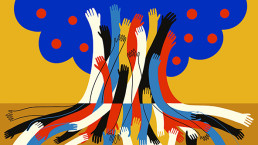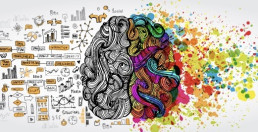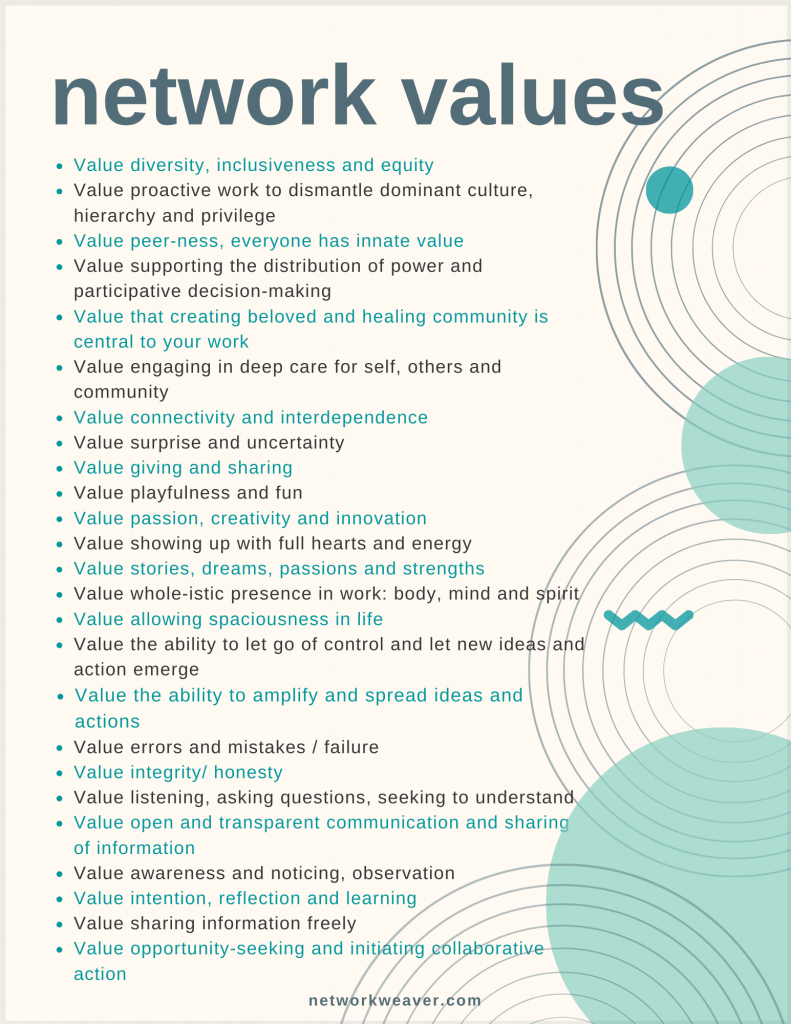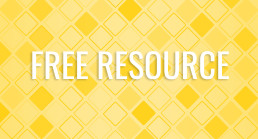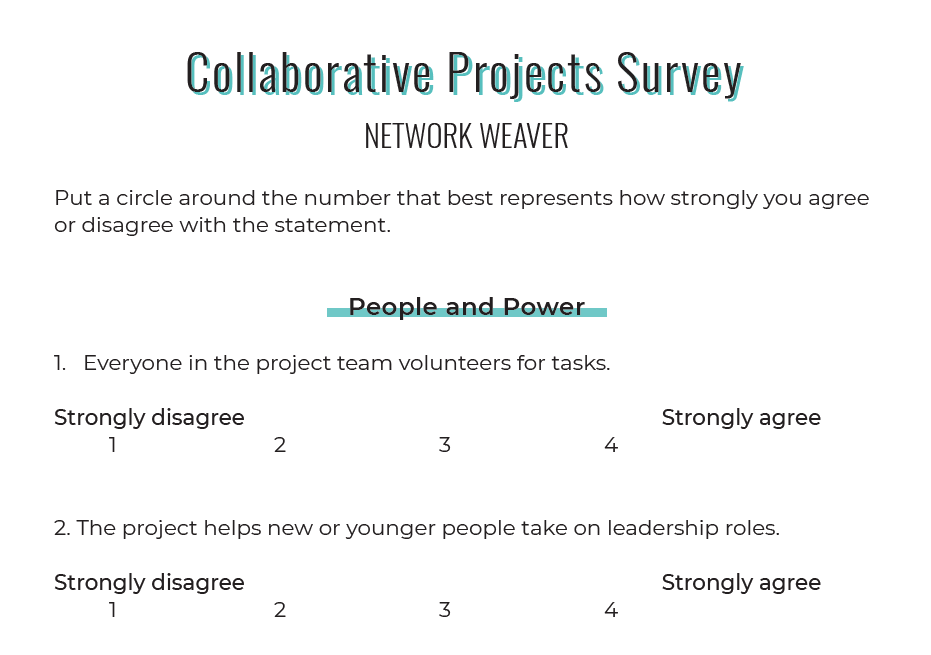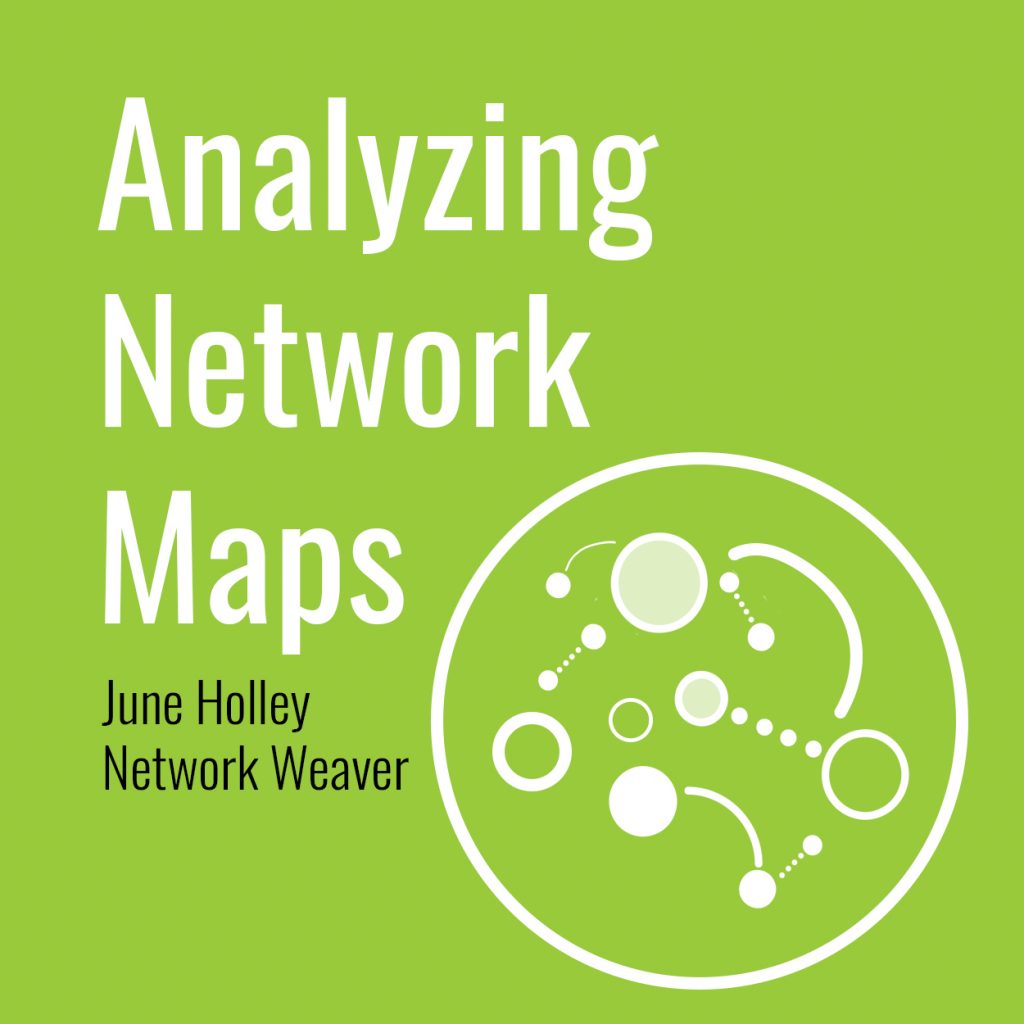Map Analysis & Weaving
Many networks (and especially funders of networks) dive into the process of generating network maps without much thought about how they will be used. The resulting maps too often end up never being seen or used by network participants. It's really a shame as network maps are extremely powerful tools that can be used to weave very healthy and effective networks. However, network mapping needs to be combined with a strategy for engaging network participants in interpreting the maps and then developing strategies for connecting people in the network and drawing in new participants.
This slide deck is about a network - the Innovation Learning Network (a network of hospital systems across the U.S.) - that implemented a highly effective strategy to use their maps.
Several aspects of their strategy that are worth emulating:
1. The network had hired two network weavers but those network weavers did not take on the mapping and weaving job alone. They recruited about 25 network participants who were interested in learning more about network weaving to implement their weaving strategy.
2. The entire group spent time reading and analyzing the network maps and then, based on that analysis, generating a set of activities that would help the network become a healthy and effective self-organizing network.
3. In addition to the network weavers connecting people, they set up a set of network activities that would enable network participants to get to know more people in the network, add new people to the network, and help people find others interested in the same topic or action areas.
4. They found that the most powerful strategy for improving their network was to support self-organizing: helping people find others interested in a particular exploration or action not only resulted in people in that project getting to know each other quite deeply but also showed them the power of self-organizing. As a result, many many new initiatives were generated over the years that took little staff time to coordinate and yet changed the face of the healthcare industry.
5. ILN remapped their network several times to notice progress and to see areas where they needed to focus their network weaving.
6. They gathered information about the effectiveness of this network enhancing strategy.
What questions do you have about this strategy? How might you adopt and adapt the ideas presented in this case study. Feel free to share this slide deck with your local network or your funders.
Finally, I'd love to hear about ways that you used your network maps. Please share with us in the comments section below.
featured image found here
June Holley has been weaving networks, helping others weave networks and writing about networks for over 40 years. She is currently increasing her capacity to capture learning and innovations from the field and sharing what she discovers through blog posts, occasional virtual sessions and a forthcoming book.
PLEASE DONATE to help Network Weaver continue in it’s mission to offer free support and resources to networks worldwide.
A Framework For Universal Well Being
A note from the Editor: What follows is generously brought to you by The Weaving Lab and taken directly from their Framework for Universal Well Being. You can download the full document on their site, or HERE at NW.com.
INTRODUCTION
The Weaving Lab is a global community of weavers and other change leaders who are weaving empowering ecosystems for universal wellbeing.
Our central beliefs are:
• Universal wellbeing is humanity’s deepest purpose and highest aspiration
• Everyone should be empowered (equipped and inclined) to live for universal wellbeing (to practice changemaking)
• Living for universal wellbeing means choosing and acting, from moment to moment, to achieve the optimal balance between the wholly interdependent and ever-fluctuating variables that constitute personal, socio-economic and planetary wellbeing
• Every human system should have Universal Wellbeing as its central purpose - and be thought of as an empowering learning ecosystem (a system which, through the choices and actions of those in the system, senses and improves itself continuously)
• To create and improve any empowering learning ecosystem that is directed towards Universal Wellbeing, a critical mass of people in the system need to be consciously and continuously weaving change
Our mission is to weave a global learning ecosystem of weavers who are advancing the profession and practice of weaving thriving learning ecosystems.
Weaving involves:
• Aligning people: To a shared vision and values
• Fostering collaborations: Organising for collective impact
• Thinking and acting systemically
• Being a better system
To achieve our mission, we have developed this Framework to guide and inform our own work and to support change leaders anywhere in weaving empowering learning ecosystems.
Our hope is that this Framework will be used as:
• A rigorous line of enquiry for creating clarity (individually and within groups)
• A departure-point for conversation, reflection and learning
• A structure for organising and sharing stories and evidence
The Framework would not have come about without the contributions from change leaders around the world. Informed by thousands of conversations with some of the world’s most visionary thinkers and practitioners, it has been impossible to find words that perfectly accommodate everyone’s unique perspective or chosen language. The Framework should be read, therefore, as a synthesis of interconnected and overlapping ideas, and as a work in progress that will improve with constructive critique.
THE FRAMEWORK
1. UNIVERSAL WELLBEING
What does it mean to thrive?
2. THRIVING IN THE NEW WORLD
What do we have to contend with to move towards Universal Wellbeing?
3. BEING WELL AND DOING GOOD
How does human action influence Universal Wellbeing?
4. BEING EMPOWERED TO PRACTICE CHANGEMAKING
What does it mean to live for Universal Wellbeing?
5. BECOMING EMPOWERED TO PRACTICE CHANGEMAKING
How do people become empowered to live for Universal Wellbeing?
6. EMPOWERING LEARNING ECOSYSTEMS
What systemic changes are necessary to empower everyone to live for Universal Wellbeing?
7. WEAVING EMPOWERING LEARNING ECOSYSTEMS
How will systems change?
1. UNIVERSAL WELLBEING
What does it mean to thrive?
1.1. Our deepest purpose and highest aspiration: Wellbeing, quality of life, flourishing, and thriving.
1.2. Interconnectedness and interdependence: Personal, socio-economic and planetary wellbeing together
1.3. Personal wellbeing
- 1.3.1. Health (physical and mental)
- 1.3.2. Safety and security
- 1.3.3. Calm and comfort
- 1.3.4. Autonomy, freedom and competence
- 1.3.5. Self-esteem
- 1.3.6. Achievement and personal growth
- 1.3.7. Purpose and meaning
- 1.3.8. Hope and optimism
- 1.3.9. Understanding and feeling understood
- 1.3.10. Feeling interested
- 1.3.11. Playing
- 1.3.12. Caring and feeling cared for
- 1.3.13. Loving and feeling loved
- 1.3.14. Intimacy and sex
- 1.3.15. Belonging and respect
- 1.3.16. Being fairly treated
- 1.3.17. Appreciation and wonder
- 1.3.18. Happiness
1.4. Socio-economic wellbeing
- 1.4.1. Family, friends, community, relationships
- 1.4.2. Social systems
- 1.4.3. Work, money and standard of living
- 1.4.4. Rights, laws and social norms
1.5. Planetary wellbeing
- 1.5.1. Sustainability
- 1.5.2. Regeneration
2. THRIVING IN THE NEW WORLD
What do we have to contend with to move towards Universal Wellbeing?
2.1. The state of the world
2.2. Volatility, uncertainty, complexity and ambiguity
2.3. Mass distribution and mass participation
2.4. AI, automation and the 4th industrial revolution
2.5. Hyper-connectivity
2.6. New consciousness
3. BEING WELL AND DOING GOOD
How does human action influence Universal Wellbeing?
3.1. The consequences of human action: Everyone shapes the world
3.2. Intention, choosing, deciding, acting and behaviour
- 3.2.1. Consciousness, the unconscious and agency
- 3.2.2. Motivation
- 3.2.3. Emotions, moods and feelings
- 3.2.4. Needs and wants
- 3.2.5. Beliefs and values
- 3.2.6. Cognitive biases
- 3.2.7. Memory, self-identity and ego
4. BEING EMPOWERED TO PRACTICE CHANGEMAKING
What does it mean to live for Universal Wellbeing?
4.1. Being empowered: Knowledge, skills, attitudes, values, competences, qualities and potentialities
4.2. Being empowered: Ways of being 4.2.1. Being empathic and compassionate
- 4.2.2. Being self-aware and self-controlled
- 4.2.3. Being present, attentive and mindful
- 4.2.4. Being reflective and future-minded
- 4.2.5. Being helpful, kind and generous
- 4.2.6. Being open-minded, flexible and fair-minded
- 4.2.7. Being collaborative
- 4.2.8. Being communicative, assertive and civil
- 4.2.9. Being tolerant, patient and forgiving
- 4.2.10. Being courageous
- 4.2.11. Being resilient
- 4.2.12. Being conscientious, organised and efficient
- 4.2.13. Being proactive
- 4.2.14. Being possibility-minded
- 4.2.15. Being responsible
- 4.2.16. Being authentic, sincere and honest
- 4.2.17. Being adaptable, curious and growth-minded
- 4.2.18. Being imaginative, creative and resourceful
- 4.2.19. Being reasonable, critical and questioning
- 4.2.20. Being thoughtful, ethical and wise
5. BECOMING EMPOWERED TO PRACTICE CHANGEMAKING
How do people become empowered to live for Universal Wellbeing?
5.1. Being, becoming and learning
5.2. Genetics, personality, neuroplasticity and experience
5.3. Empowering learning experiences
- 5.3.1. Practicing changemaking daily
- 5.3.2. Reflecting on practice and progress
- 5.3.3. Being trusted to take the lead
- 5.3.4. Working in the community
- 5.3.5. Doing projects that are self-directed, collaborative, immersive, experiential, interdisciplinary, and challenge-based
- 5.3.6. Being in nature
- 5.3.7. Using technology
- 5.3.8. Exploring the sustainable development goals
- 5.3.9. Debating the state of the world
- 5.3.10. Questioning the status quo
- 5.3.11. Exploring and celebrating diversity
- 5.3.12. Practicing peace-making
- 5.3.13. Playing, making art and telling stories
- 5.3.14. Discussing holistic human development
- 5.3.15. Practicing meditation and mindfulness
5.4. Monitoring and measuring progress
6. EMPOWERING LEARNING ECOSYSTEMS
What systemic changes are necessary to empower everyone to live for Universal Wellbeing?
6.1. 1st line actors directly influence the experience of others
6.2. 2nd line actors indirectly influence the experience of others
6.3. Collaboration at every scale is essential
6.4. Complex systemic changes are required
6.5. Changing systemic mechanisms and mindsets
- 6.5.1. Building trust, enhancing communication, raising voices
- 6.5.2. Creating new roles, empowering every actor
- 6.5.3. Building capacity in the system
- 6.5.4. Changing progression routes and incentives
- 6.5.5. Changing policies
- 6.5.6. Shifting funding
- 6.5.7. Applying technologies
- 6.5.8. Changing measures
- 6.5.9. Redefining success
- 6.5.10. Shifting mindsets and behaviours
7. WEAVING EMPOWERING LEARNING ECOSYSTEMS
How will systems change?
7.1. Everyone contributes to change
7.2. Change leaders lead the way
7.3. Vibrant communities and effective teams will be crucial
7.4. Change leaders must align, collaborate and act systemically
7.5. Weaving is essential to continuous change 7.5.1. Aligning communities to a shared North Star
- 7.5.2. Fostering collaborations and organising
- 7.5.3. Weaving involves building conversations and demand
featured image found at ssir.org
The Weaving Lab trains leaders, cultivates research, builds networks and advises organisations working to weave thriving communities.
The Weaving Lab is growing the field of weaving – deepening its practice, advancing research, and strengthening the community of practitioners – so that together, we can effect systems change that enable people and planet thrive.
PLEASE DONATE to help Network Weaver continue in it’s mission to offer free support and resources to networks worldwide.
6 Tips for Making Online Collaboration More Productive and Engaging
In reflecting on a meeting I helped organize for a multi-organization, multi-stakeholder network, I realized that there’s more to online collaboration than using the right technology and best practices.
In July 2020 a survey was conducted by Collective Impact Forum about how collaboration has changed as a result of the combined effects of COVID-19, a prolonged economic downturn, and racial justice uprisings. Almost half of the challenges most commonly identified involved new ways of working together and relating to each other in an online environment. These included difficulty adapting programs to a physical distancing context, lacking the quality of experience that comes from working together in person, and encountering Zoom fatigue.
For our online meeting, an intimate experience was created by inviting attendees who faced similar challenges. Ground rules were set at the beginning of the meeting to provide a safe space for open dialogue. Network members modeled trust-based vulnerability by sharing pivotal experiences that led to broader change in their organization. Guided small group discussions enabled participants to connect with each other on a deeper level. Through an action learning approach participants gained valuable insights and identified solutions to challenges faced in their work. A break mid-way through the session provided an opportunity for everyone to step away from their electronic devices to rest and re-charge.
It takes a village to create an online community
A successful online meeting takes support. Although we often think of support in terms of tangible elements, like technology and best practices, they are insufficient on their own. There is also a human dimension to support systems that often doesn’t get talked about—unless things go wrong. What ultimately made the difference in this situation was the formation of an online meeting production team whose members were committed to achieving the same goal. Demonstrating effective collaboration behind the scenes contributed to a successful online meeting and a stronger team.
Tips for making online collaboration more productive and engaging
1. Assemble a team and bring them together early on in the planning process
Days before the online meeting the organizers realized they needed a bigger production team. Having good relationships with her co-workers made it easier for the facilitator to quickly bring a few additional people on board and orient them to their roles. Identify the different roles needed for your online meeting in advance and recruit people to fill them. Limit the number of tasks (e.g., facilitation, note taking, time-keeper, managing the technology platform, monitoring the chat, etc.) each person is expected to do so that multi-tasking doesn’t result in important details falling through the cracks. It’s also a good idea to have a back-up person whose primary function is to be ready to step in if a team member needs additional support.
2. Allocate more time for organizing online meetings
Planning for online meetings often takes longer than in-person meetings because of additional factors to be considered. Think through in advance how the meeting will take place, from start to finish, beginning with the purpose. How will you structure the meeting to accomplish your goals? How will you enable participants to actively participate? How will you support the meeting production? Help team members work together instead of assuming they will figure out what needs to happen and how to get it done on their own. This involves making sure people understand their roles and what is expected of them. Provide team members the resources and any training needed to accomplish their tasks. Determine in advance how team members will communicate with each other during the meeting, such as through texts, to share information, address problems, and make decisions.
3. Create a valuable experience for everyone
In addition to creating the content for your meeting, plan in advance the kind of experience you want to create for participants. How will you welcome people as they enter the online meeting room? Greeting each person by name as they arrive can help set a welcoming tone. How will you engage people in the conversation? Some examples are using polls, providing opportunities for people to ask questions, and building time into the agenda for reflection and sharing insights. Mixing people from different industries and sectors in virtual breakout rooms allows for conversations they wouldn’t ordinarily have that can potentially lead to breakthroughs in solving problems. Creating the space for networking, such as by randomly assigning people to breakouts, can foster spontaneous collaboration. Design your meeting so that in addition to advancing collective goals, participants come away with ideas, insights, and resources they can use in their own work.
4. Practice makes better
To ensure your online meeting runs smoothly, create a “run of show” document that explains in detail what will happen from start to finish. This includes estimated times for each section of the agenda, what resources are needed, and what tasks each team member is doing for each segment of the meeting. Organize run throughs for both speakers and the meeting team to help prepare them and test the technology. Run throughs can also foster teamwork by encouraging people to contribute their ideas for improving the meeting as well as giving and receiving help.
5. Invite people to bring their whole selves into the room
Online meetings can also serve as opportunities to engage people in a variety of ways. Design your meeting to offer more than a learning experience. Create the space for people to engage with their hearts (connect with each other on a deeper level by discussing what really matters), hands (make something together, like an action plan), and spirit (align around common goals, action items, or next steps). To learn more about this approach, check out Co-Creative Consulting’s 4 Agendas in Collaborative Innovation.
6. Create the space for learning on multiple levels
After your online meeting organize a debriefing that includes speakers, facilitators, and members of the production team to capture lessons learned about how the meeting went and the experience of working together. This can be as simple as taking turns answering these questions: What worked well? What can be improved upon for next time? Create the space for personal growth by inviting people to share what they learned about themselves from this experience.
My takeaway from working with networks in an online environment is that successful collaboration is as much about what happens behind the video camera as in front of it.
Originally published at See Change
featured image by Chris Montgomery on Unsplash
Kimberley Jutze is a social activist and founder of Shifting Patterns Consulting, a Certified B Corporation that helps changemaker leaders work better together to achieve greater impact. She specializes in helping networks and other collaborative groups increase their productivity and engagement. You can follow her on Twitter at @ShiftPatConsult and LinkedIn
PLEASE DONATE to help Network Weaver continue in it’s mission to offer free support and resources to networks worldwide.
Can problem-solving itself be problematic?
Intelligence is usually defined in terms of capacities like the ability to learn, to plan, to recognize patterns and to solve problems. So it has been hard for me – as an advocate of collective intelligence – to come to terms with the profound short-comings of problem-solving.
Problem-solving is universally respected and applied: If there’s a situation we don’t like, we believe it needs to be approached as a problem and solved. If the responsible person fails to solve it well, that’s their fault, not the fault of the problem-solving approach, itself.
In this essay I invite you to consider that problem-solving – as a way of handling troubling situations – has more pitfalls than most of us realize. In an ironic nutshell, there are some problems with problem-solving.
I find the very idea shocking. Problem-solving is so embedded in our thinking and language that it is hard to conceive of addressing challenges without trying to solve them as a problem. The problem-solving worldview is ubiquitous in our culture. I now think that that worldview generates a growing shadow for our civilization – a civilization profoundly dependent on the very problem-solving impulse that is making it increasingly vulnerable!
I’ve been considering how many of today’s “issues” and “crises” are rooted in earlier solutions. Consider, for example, what solution-based Progress looks like when we take account of its downsides:
- Better housing insulates us from “the elements”, thereby serving to alienate us from nature, dulling our instincts and capacity to respond with appropriate insight and urgency to environmental degradations unfolding around us. [ap_spacing spacing_height="5px"]
- Advanced medical care and provision of calories “solve” hunger and disease while expanding humanity’s environmental impact and frequently undermining deeper dimensions of individual, communal and environmental health. [ap_spacing spacing_height="5px"]
- Getting efficiently from A to B and acquiring our favorite products has disrupted Earth’s climate, depleted its resources, and generated massive amounts of garbage and toxicity. [ap_spacing spacing_height="5px"]
- Institutions to support people in need have generated systemic dependency and undermined traditional modes of mutual and communal caring and nurturance. [ap_spacing spacing_height="5px"]
- The efficiency of money, mass production, mass commodification and mass mobility tend to replace relational interdependence, uniqueness, meaning, reciprocity, community and artisanship. [ap_spacing spacing_height="5px"]
- Communication technologies have transplanted us from communities of place to virtual networks of like-minded people far away, decreasing local social capital needed for physical communal resilience.
People are busily working on solutions to all the solution-generated problems noted above, while the whole interconnected body of life and its support systems are coming apart. I’m not saying we shouldn’t do things “to improve people’s lives”. I’m saying it seems wise to take better account of the downsides of our current approaches because, as novelist Phillip K. Dick notes, “Reality is that which, when you stop believing in it, doesn’t go away.” What we don’t take into account usually comes back to haunt us, sooner or later.
PROBLEMS WITH LINEARITY
Most of the shortcomings of our problem-solving worldview are grounded in the fact that it is fundamentally linear and the world is fundamentally non-linear. More often than not, the bigger the situation being addressed, the more nonlinear it is and the harder it is to understand, predict and control it. We can add to that challenge the fact that our “successful” problem-solving at smaller scales (like a decision to travel by jet instead of train) is generating ever-vaster problems at larger scales, thanks to how many of us are led to prefer problematic options.
This is one example of how our problem-solving efforts take us on an A-to-B fantasy trip from identifying the problem to finding a solution that makes the problem disappear. We believe in this simple story, even when evidence suggests it is incomplete and misleading. When things go wrong, we think that we (or someone) didn’t solve the problem correctly. We don’t think that there might be some issues with problem-solving, itself. After all, we see it working so well for small, simple, mechanical (non-living) challenges like fixing a flat tire – and even for complicated challenges like sending someone to the moon. (See my writeup of the Cynefin framework.)
Unfortunately, the linearity of problem-solving becomes troublesome when it is applied to large, complex, nonlinear situations and systems. These are the most common types of situation faced by organizations, communities and societies today. They are extremely messy even to try solving and, more often than not, when we implement such a solution we generate “side effects” which often become problems that demand solutions of their own, ad infinitum, as suggested by the bullet list above.
Problem-solvers even have a name for the most problematic problems. They’re called “wicked problems” because they are virtually unsolvable. The more alive and complex a situation or system is, the more it features interactive moving parts, vast influential contexts, autonomous agents, and evolving demands on the solvers, themselves, to dance and transform in ways that make any “solution” temporary, at best. All this interrelational movement thwarts our efforts to nail down The Problem and arrive at a final Solution that actually makes the problem go away.
The effort to apply problem-solving approaches to messy, wicked problems tends to not only fail to work as expected, but to generate hubris and tunnel vision in us as problem-solvers. We become captivated by the heroic narrative of generating clear solutions and thus reluctant to acknowledge how such complex systemic problems tend to have many tangled causes and how our solutions almost always generate new problems. We are inclined to underappreciate, downplay, or fatally ignore the evolving web of factors that make a satisfying solution so elusive. We hang on to our linear sense of problem-solving success.
IS PROBLEM-SOLVING ACTUALLY APPROPRIATE IN THIS CASE?
If we want to use problem-solving approaches wisely, we need to recognize where they may not be appropriate, and to deeply understand why that is. It also helps to know what approaches to use instead.
I offer below a list of some characteristics of situations, conditions and systems that do not respond well to problem-solving. None of them are cognitive deal-breakers or impediments to productive engagement; there are alternative approaches that can help us work with them. For each characteristic, I’ve included examples of approaches that would probably work better than traditional problem-solving. As with so many of my lists, this one is not to be taken as comprehensive, but rather as a doorway into thinking differently about this remarkably nuanced topic.
- If we encounter significant novelty and surprises in the problem domain, we’ll need to use less problem-solving and more openness, curiosity, exploration, and creative prototyping. As we learn more, we MAY be able to shift into problem-solving mode, but always very judiciously. [ap_spacing spacing_height="5px"]
- Where the problem domain is embedded in contexts – social or natural systems, histories, assumptions, etc., that seem to be in the background but actually shape or are impacted by the problem domain – we can investigate those larger contexts and convene generative conversations among players in them before attempting problem-solving. Often, deeper understanding of the situation and relations among the players will shift the context in ways that cause the original problem to shrink or dissolve entirely. [ap_spacing spacing_height="5px"]
- Where the problem is linked to other problems – e.g., at different scales, places, times, nodes of systemic causality, etc. – we’d be wise (as above) to undertake investigations and conversations about – and among players in – those related problem domains before even thinking of solving the original problem. Unacknowledged and ignored interconnections between problem domains is a major reason why solutions in one domain create problems in other domains. Of course, the more connections we acknowledge, the more complex we realize “the problem domain” actually is, challenging us to use even less linear approaches. [ap_spacing spacing_height="5px"]
- Where we find true complexity – in other words, constant interactivity, change, evolution, and emergence happening among elements within the situation – our responses require openness, diversity, fluidity, resilience, “dancing” with change and “surfing” the waves and rapids of change rather than problem-solving. Literally “solving” something in such a situation is futile because any “target“ for our efforts is always moving and morphing, often in response to whatever we do (and even who we are). Ideally, our level of responsiveness would reflect the level of mutual responsiveness unfolding among the other elements in the system. Improvisational dance might be the best metaphor for a workable approach. We would not see ourselves as separate, fight against the interactive energies, or push a prefigured plan. [ap_spacing spacing_height="5px"]
- In response to significant but intrinsic uncertainties, it is most appropriate to respond with humility, intuition, appreciation, and exploring multiple perspectives in search of recognizable patterns rather than just trying to deny or solve the uncertainties so we can be certain enough to start problem-solving again. [ap_spacing spacing_height="5px"]
- If we’re confronted by a polarity whose elements are deeply interdependent parts of a dynamic whole – such as freedom/equality, short term/long term, individual/group, etc. – their tension cannot be “solved” in the usual sense. They need to be managed for greater synergy, short-term situational prioritization (where one or the other side of the polarity is temporarily prioritized), and a long-term balance that is dynamic, not static. [ap_spacing spacing_height="5px"]
- Predicaments – conditions that simply cannot be solved – challenge us to accept what’s going on, to minimize what harms may be associated with those conditions, to change ourselves as needed[*], and to support each other and the healthy functioning of whatever system the predicament is embedded in. In this, we may find the Serenity Prayer helpful: “God grant me the courage to change what I can change, the serenity to accept what I can’t, and the wisdom to know the difference.” [ap_spacing spacing_height="5px"]
- Finally, Mystery is always present, inviting us to learn or deepen into the implicit awe-inspiring qualities of life and existence. Such learning and deepening can go on forever. Problem-solving is often a way to skip over that dimension of our experience – but we can always shift into Mystery at any time, simply for its own sake (setting aside the whole problem-solving impulse), or to gain perspective (since certain habits or assumptions can limit our view of what’s important or possible), or to make space for more creativity to help our problem-solving become richer and wiser. This may open the door to some of the less linear approaches listed below….
ALTERNATIVE PROCESSES
Some consultants note that the effort to solve problems can lower a group’s energy – despite the fact that some analytically inclined members of the group may enjoy that mode of thinking. Various exercises – creative, physically active, etc. – can be used make group problem-solving more enjoyable.
But that can make an unhelpful activity bearable. Luckily, there are totally different approaches to deal with undesirable conditions – other than problem-solving. These include the following, which I again offer with all my earlier caveats regarding lists! [Any processes not linked herein can be found here.]
- Active or strategic appreciation. This linked essay lists some process resources for this approach as well as this challenge to our imaginations: “What would happen if we deeply understood what was going on, if we saw and were truly grateful for the positive aspects of it and, in addition, if we used that recognition to help those positive aspects and possibilities become more present and alive in the situations we were addressing?…. [Rather than] pushing what we want to change towards a predetermined outcome… [What if] we’re evoking responses from the aliveness that’s already present or trying to help that aliveness show up more fully among us. As an approach to purposeful action, it’s more aligned to the nonlinear nature of chaos and complexity than traditional problem-solving approaches.” [ap_spacing spacing_height="5px"]
- Conversation that evokes emergent shared understandings of what’s going on and what makes sense – e.g. Dynamic Facilitation and Convergent Facilitation [ap_spacing spacing_height="5px"]
- Breakout-based gatherings where multiple perspectives on and dimensions of the situation can be explored with like-minded others – e.g., Open Space Technology, Warm Data Labs, and Ephemeral Group Process [ap_spacing spacing_height="5px"]
- Creating contexts and awareness of relationship, resonance, reciprocity, and co-creativity not just with each other, but with all the elements of the situation or reality involved – e.g., Nonviolent Communication and Braiding Sweetgrass [ap_spacing spacing_height="5px"]
- Using the challenges of the situation for psychospiritual development, individually or collectively[*] – e.g., Mindfulness meditation and Bohm Dialogue [ap_spacing spacing_height="5px"]
- Using the challenges of the situation for systemic transformation – as when social change organizers help people see how the unpleasant aspects of their lives arise less from their personal inadequacies than from the dysfunctional systems in which they are embedded and which shape their lives, thereby inspiring them to act to transform those systems. See “the personal is political”
A CLOSING REALIZATION
On a break from writing this, I began to wonder to what extent problem-solving is related to our desire to predict and control, to impact the world and not have it impact us. This adds a wider lens through which to consider these “problems with problem-solving”.
More generally, I’ve been seeing more and more aspects of my work and vision falling into a spectrum between (a) order, prediction and control and (b) reciprocal learning, adaptation and relationship. Creativity and intelligence seem to be important factors at both ends of that spectrum, but (b) involves more CO-creativity and CO-intelligence.
I’ll be writing more on that soon, I suspect…..
Coheartedly,
Tom
Originally published at tomatleeblog
featured image found HERE
I'm interested in conscious evolution as an active and integrated process of personal and social transformation, as well as many subsets of that -- collective intelligence, evolutionary spirituality, wise democracy, emergent economics, etc. My main home website is http://co-intelligence.org

Collective Mind Community Conversations
The impact of the pandemic on networks: Learning from network managers’ experiences
Collective Mind hosts regular Community Conversations with our global learning community. These sessions create space for network professionals to connect, share experiences, and cultivate solutions to common problems experienced by networks. In November 2020, Collective Mind hosted a special series of our regular Community Conversations to learn from one another’s experiences of managing networks during the Covid pandemic.
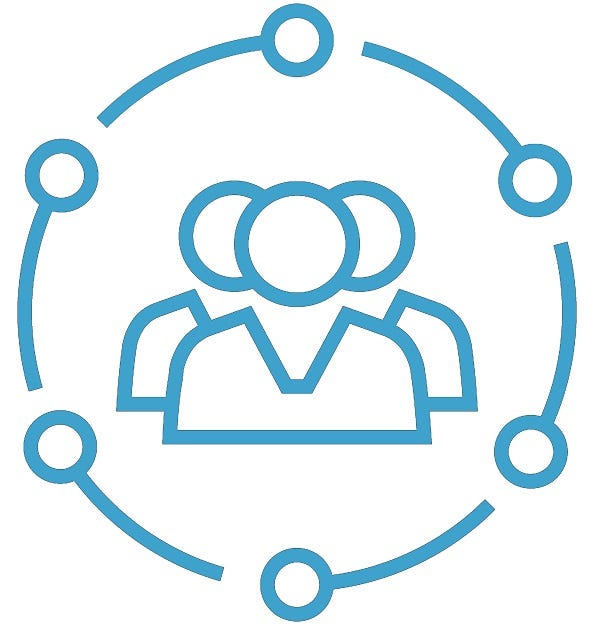
The proverbial wrench that the Covid pandemic has thrown at us all cannot be understated. We’ve had to adapt our lives, work, and workplaces in unanticipated ways while long-term questions continue to linger. For networks and their staff, the impact of the pandemic has raised unique challenges for an already challenging field of practice.
Networks — a catch-all phrase for various types of collective organizing models — function by coordinating members to actively co-create value, community, and impact toward achieving a shared purpose. Behind networks that work in climate change, education, philanthropy, and everything in between, network staff work diligently in service to and in support of their members to accomplish collective goals. In the best of times, network staff wear many hats on behalf of their members: administrator, facilitator, technical expert, cheerleader, counselor, connector, coordinator, wrangler, problem-solver, communications liaison, and more. But in the midst of an enduring global pandemic, new struggles have emerged and old struggles have become amplified.
While many real and threatening struggles persist, the pandemic has also been an opportunity for networks to learn, reflect, and evolve. Eight months in, necessity has led to innovation and the initial experience of shock and uncertainty has transformed into new practices and mindsets. These lessons, insights, and tips from a diverse, global audience of network practitioners give us hope and remind us of the power of networks.
What are networks experiencing in this pandemic, and what can we learn from network managers who have weathered this year?
Building new relationships and partnerships in a pandemic can be challenging — but the pandemic is also an opportunity for more intentional collaborations. The dearth of in-person interactions has made it more difficult to create organic connections, both among network members and with potential outside partners. In-person gatherings offer us chances to meet, engage, and collaborate with colleagues and new contacts in a way that Zoom meetings struggle to recreate. Networks often rely on the spontaneous, serendipitous connections made face-to-face as both a key benefit of being part of the network and as fuel for network engagement. Without in-person spaces, building relationships has felt stilted.
At the same time, moving most of our lives online has opened doors for accessing and discovering new people and creating value together in different ways. Relying on social media and virtual outlets to connect us has become a sort of equalizer, as has the humbling experience of letting the world into our homes through a computer camera. And instead of passive exchanges with many, we’re investing our energy more selectively. As a result, network managers have been forging action-oriented connections with more tangible goals and outcomes. They’re asking important questions such as, what could be mutually beneficial about this relationship? How can we uplift each other, share platforms, and open doors together? What is worthy of everyone’s time? The result is intentional partnerships, anchored in and driven by action and shared value — much like the impetus of a network. Within networks, staff have had to make network weaving more explicit. It can take effort to create virtual collaboration spaces, manage new means of member engagement, or step in to build links and bridge connections. But creating more diverse outlets and on-ramps for connection may also have been overdue (more on this below).
Networks can struggle to stay relevant as members retreat into their own organizations — but there has also been an opportunity to engage members differently and make creative pivots to meet the new operating environment. The upheaval of the pandemic rapidly created unknowns for organizations around funding, staff, programmatic viability, and more that, for many, shifted their focus inward and away from outside commitments. Fostering a network mindset among a membership is already a constant effort but the pandemic created new uncertainties for networks about how to stay relevant to their members, how to fulfill network obligations when participation is unpredictable, and how to maintain engagement without the same ability to bring expected value and benefits to members as before. The pandemic has also affected the missions and activities of some networks, forcing a shift in priorities to meet new demands and address pandemic-related fallout.
In this new landscape, networks understand that they cannot rest on their laurels. Staying relevant and effective requires shaking up norms and embracing new possibilities. Faced with member disengagement, network staff have reimagined opportunities for new kinds of engagement. Listening to members and seeking to understand their needs has been critical for networks to adapt, be responsive, and maintain value. Where possible, staff have gone out of their way to get to know more network members personally and learn directly from them about what an updated value proposition for the network could be. While opening up new avenues for engagement, networks have also embraced the reality of what can get done and how, choosing to postpone or adjust certain network activities.
By centering members in the process of adapting, networks have identified and created paths for leaders to emerge in new ways. They’ve been able to lean into those who have stayed at the table and empower engaged members as network weavers. Leveraging expertise from across the network — like facilitating new groups or sharing skills — has generated new kinds of leadership, and tailoring content for subgroups around their specific interests has helped keep members’ attention. Network staff have had to expand their skillsets and stretch their job descriptions for the sake of stewarding the network. But embracing emergence and relying on members to help shape the network has served to reinforce the origins and intent of a collaborative networks practice.
While we lean on new technology more than ever before, no one tech platform seems to be a silver bullet (yet) — and this may be the lesson we needed all along. For many networks, virtual engagement and collaboration had begun trending long before the pandemic. For others, upgrading technology and transitioning to online platforms was not seen as a priority. Regardless of experience, the pandemic quickly required network staff to become savvy technical administrators and, most importantly, amplified the crises of tech barriers, inequality, and gaps in internet access and stability. Network memberships with older demographics, limited tech experience, and gaps in digital fluency have struggled. Across the board, the impact of relying on tech for participation and the implications for member inclusion and equitability have been significant challenges.
In truth, many of these issues were not new to the pandemic. Social and infrastructure disparities have always persisted (especially between global memberships and Western-led secretariats), and effective technology has been a moving target for years. A meaningful pivot toward embracing tech and finding solutions for inclusion has been a long time coming, and in this way, the pandemic has pushed us forward.
Networks have skilled up and committed to finding solutions to virtual connection, experimenting with a huge range of platforms. They’ve often found that using what people know wins out and that the path of least resistance cannot be underrated. Practitioners emphasize that it’s critical to know and center your audience: some memberships have the skills and bandwidth to use flashy tech platforms, while others will need to use what they know and can access, like Facebook and email. The key is to use what works for your network and build on it, and to accept the inevitability that it may take multiple platforms and channels to address different learning styles and communication preferences. While new platforms can feel annoying or daunting for members, practitioners have found that steadily integrating them as go-to resources, and even giving tutorials or extra guidance, can create new habits and foster successful adoption of new technology. And in the spirit of networks practice, many network managers have also learned to fight the urge to be a gatekeeper to virtual connections or to force uptake of new tools for online collaboration. Staff must often lay the groundwork, but networks flourish by observing and learning from members’ behaviors while allowing for emergence.
The pandemic has tested us — but it has also allowed for personal strengths to evolve and shine. Managing networks effectively involves hard and soft skills, like listening, facilitation, organization, and flexibility. The need to hold space for members during a pandemic has pushed network practitioners to flex these personal attributes, cultivate new skills, and learn about themselves in new ways. Many shared that they have learned to sit with uncertainty — to be resilient and agile, to accept that we might not know what’s going to happen next, and to embrace what comes. Centering practices such as learning, listening, and balance has become essential in work and in life. They’ve also learned to reject rigidity and perfection, and to allow for emergence within the network and in what demands and opportunities come to staff. Ultimately, network managers have been focused on relationships: investing in them, building them, stewarding them, and celebrating them. Relationships anchor networks and relationship management is a core and common skill of network managers. These network management skills are a constant practice, and in these challenging times, practitioners have certainly risen to the occasion.
Collective Mind seeks to build the efficiency, effectiveness, and impact of networks and the people who work for and with them. We believe that the way to solve the world’s most complex problems is through collective action – and that networks, in the ways that they organize people and organizations around a shared purpose, are the fit-for-purpose organizational model to harness resources, views, strengths, and assets to achieve that shared purpose.
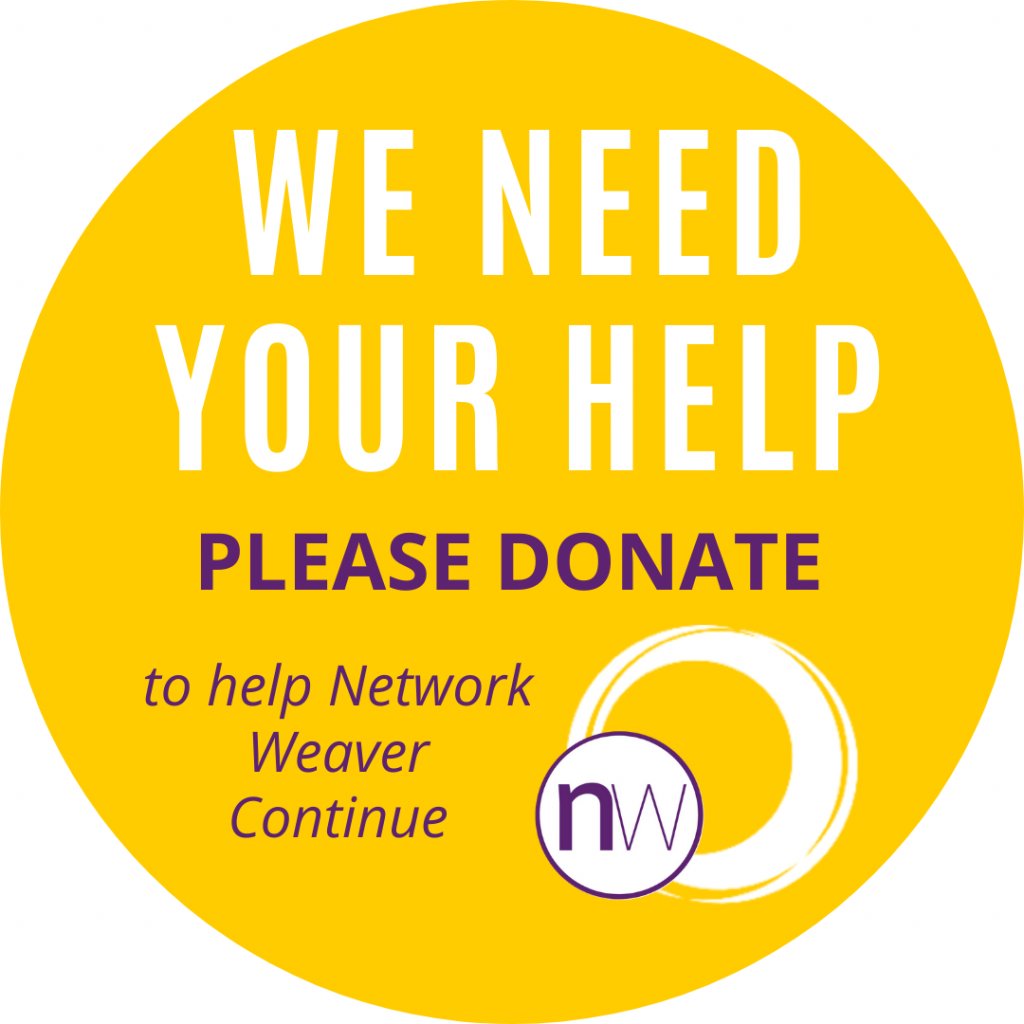
Originally published on Medium / Collective Mind
Network Training Slide Decks
We are offering a new section in our Resources section: a set of presentation slide decks that can be used by you for training or sharing with people who want to learn more about networks.
You can edit or mix and match any of the slides into a custom slide deck that will work best for your audience. All the slides are creative commons but please do credit the networkweaver site in your final slide deck.
The first two decks are Network Basics and Network Skills.


If you have presentations that you have created and are willing to share please send to NetworkWeaverManager@gmail.com and we will include in our Resources section.
NETWORK VALUES
Having a group or network take a values survey raises awareness of the values and behaviors that enable networks to be system shifting or transformational.
Network Weaver has published a Network Values Module. Within this module are links to two web-based network values surveys, along with instructions. Also included are printable versions of the network values surveys and a printable flyer of a compiled list of Network Values.
Download the free module HERE
PURPOSE OF NETWORK VALUES SURVEYS
The purpose of having a group or network take a values survey is that it raises awareness of the values and behaviors that enable networks to be system shifting or transformational. It also gives clear information about the specific value areas where they need to work together to help each other shift to more network ways of being. People take the survey, immediately see the aggregated results, and work together to develop strategies for shifting challenge areas.
It’s extremely valuable for groups of networks to take the survey every six months (or even more often at first) so that they can see the progress they have made in shifting to network values and identify areas that still need attention.
There are two values surveys in this module.
- #1 Network Values Checklist
- #2 Network Values Dashboard (for individuals and organizations)
The first one is for individuals. It is used to help individuals identify the areas where they are already behaving from network values. You can have the group aggregate the results of everyone who took the survey so that they can see to what degree they as a group or network have shifted to network values and behaviors.
The second survey has two versions of each question. The first asks the individual about their values. The second asks the individual to rate how their organization ranks in reflecting this value or behavior. Usually the participants will score higher than their organizations. This survey helps people recognize that they cannot simply shift their own values, but need to work with their organizations to shift the entire organizational culture – if they want to be transformative in their impact.
Download the Networks Value Module HERE
Collaborative Projects
This Collaborative Projects Survey can be used to help collaborative work or learning projects increase their awareness of their strengths and challenges and enable them to see the skills that need to be built by the group.
The free resource includes a “hard copy” of the Collaborative Projects survey that can be printed out and handed out to people at project meetings. It also includes an instruction sheet which includes a web-based version of the survey that people can take during a meeting on their smartphones or the link can be provided during a virtual meeting for people to take and immediately see the results.
I highly recommend the web-based version as it enables the participants to immediately see the results for the entire group.
Let us know if you use the survey, any suggestions for changes and improvements, and whether your group found it useful.
Download the survey HERE.
The Importance of Learning in Networks
We are seeing a shift in the social transformation space from evaluation to learning and support for change. Evaluation has too often been a judgment-based, funder driven approach to determining whether progress has taken place that tends to penalize risk-taking and innovation and focus mindlessly on outcomes even when it’s not clear what the solutions are.
System-shifting networks are sets of organizations, individuals and funders who are committed to innovating, experimenting, collaborating and learning to shift to healthier systems. In such networks, participants need a system of support that enables learning and change to happen on individual, organizational, collaborative project, network, culture and system levels: it’s what is called fractal change. *
*A fractal is a phenomenon in nature or mathematics that manifests as a repeating or self-similar pattern at every scale.
From my experience, I’ve seen change and learning are most likely to happen in collaborative projects and when scaffolding for learning is in place. So if we want to track anything as our networks go forward, it would be in these two places.
[ap_spacing spacing_height="10px"]
A. The scaffolding for learning consists of the following:
- Trained catalysts: Facilitators who enable people in collaborative projects to pick up network culture/values, skills and practices more rapidly (especially equity) and help projects be more successful; learning weavers who capture what is learned and share with the network so all benefit from learning in the project. [ap_spacing spacing_height="10px"]
- Innovation funds that not only support these projects but bring together funded projects in Communities of Practice where participants learn how to learn more explicitly. [ap_spacing spacing_height="10px"]
- Just-in-time tracking (for example surveys on things like network values and network leadership) that participants use to see where they (as individuals, groups, networks, etc) are having challenges in shifting to a network way. Having quantitative measures enables the individual, group or network to quickly determine strengths and challenges and then develop strategies to shift those challenges and later see if those strategies worked. We have developed surveys on network values, network leadership, collaboration skills and whole network assessments, see resources. [ap_spacing spacing_height="10px"]
- Cross-network learning and sharing sessions: networks (or more usually projects) reach out to learn from other networks. This learning is shared with the field. [ap_spacing spacing_height="10px"]
- A communications system that makes it easy to share learning within projects, among projects, with the network and with other networks. [ap_spacing spacing_height="15px"]
B. Collaborative projects are where people collaboratively work on shifting their own values and behavior in a supportive, nurturing environment and at the same time are continually trying new approaches and learning from what they do.
We could greatly benefit by focusing on these small groups as the petri dish of transformation: introducing different practices and discovering which have the potential for both personal and network transformation.
The trick to scaling change is to support the change that happens in collaborative projects to ripple out throughout the network and on to networks of networks.
So what would be helpful is for those of you who are network evaluators to watch and record and reflect back the whole network:
- Is change happening in projects? When is it most successful? What are participants doing that seems to accelerate individual and collaborative change? [ap_spacing spacing_height="10px"]
- What scaffolding is in place and functioning well? Where is work needed? How are these pieces of the scaffolding supporting learning? What aspects seems to be the most effective is supporting learning? [ap_spacing spacing_height="10px"]
- Is learning spreading from projects to network? From projects and networks to networks of networks? How is it spreading? What accelerates spreading? [ap_spacing spacing_height="10px"]
- Is learning being applied to future projects? Examples? Can we follow the path? What enables people to use other people’s/project’s learning?[ap_spacing spacing_height="15px"]
Another interesting aspect of self-organizing networks (where people are involved in several collaborative projects at any one time) is the flow of innovations from one project to other projects as the participants in the original project share their innovations with their other projects. This is how zoom became the standard for most networks - early adopters like me used it with all our projects and its use spread with amazingly rapid speed. It would be really useful to see if this kind of spread of other innovations generated by projects or networks could be tracked to determine how spread could be accelerated.
I feel that learning has been grossly underdeveloped in networks. I believe that if we started spending much more of our time in learning while we are doing, transformation could occur quite quickly.
So please start experimenting and sharing back with us what you learn about learning!
Analyzing Network Maps
Having network maps is a wonderful thing - but not if you can't read what they are saying! This free resource offers some basic strategies for interpreting network maps.
Network maps can have a transformative effect when as many network participants as possible are involved in interpreting the maps and then developing strategies to more effectively weave the network. So it's important to share these slides with your network and then have activities where network participants can use them on the network's maps.
I suggest that you talk about each slide, then have people in small groups see if that feature exists in their network map. If it does, they can generate ways to correct the network. For example, if the map shows that people from grassroots organizations are all on the periphery of the map, while larger non-profits are in the core, then the small groups can generate actions to connect people from grassroots groups with people in the core. It's best if individuals make commitments to make these connections. At your next network meeting, you can have then add the new connections to a blown up network map that you post on the wall.
[ap_spacing spacing_height="20px"]

[ap_spacing spacing_height="30px"]
Click Here to Download
[ap_spacing spacing_height="45px"]



